Superfamily Apoidea Scientific name Xylocopa Higher classification Xylocopini | Suborder Apocrita Tribe Xylocopini Order Hymenopterans Rank Genus | |
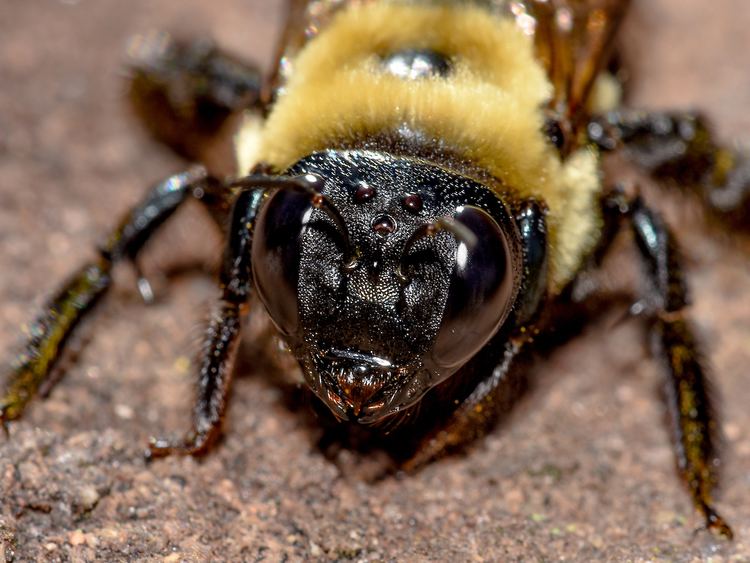 | ||
Lower classifications Xylocopa violacea, Eastern carpenter bee, Xylocopa varipuncta, Xylocopa sonorina, California carpenter bee | ||
Carpenter bees millie davenport
Carpenter bees are species in the genus Xylocopa of the subfamily Xylocopinae. The genus includes some 500 species in 31 subgenera. Members of the related tribe Ceratinini sometimes are called "small carpenter bees". The common name "carpenter bee" derives from their nesting behavior; nearly all species burrow into hard plant material such as dead wood or bamboo. The main exceptions are species in the subgenus Proxylocopa; they dig nesting tunnels in suitable soil.
Contents
- Carpenter bees millie davenport
- Why carpenter bees drill holes in houses a moment of science
- Etymology
- Characteristics
- Ecological significance
- Behavior
- Natural predators
- References
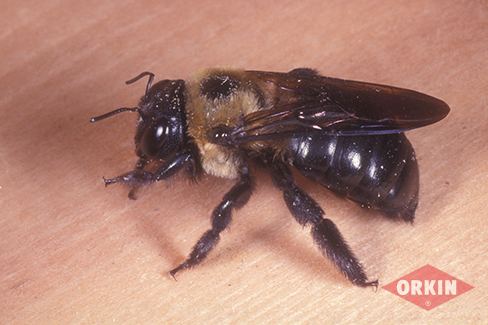
Why carpenter bees drill holes in houses a moment of science
Etymology
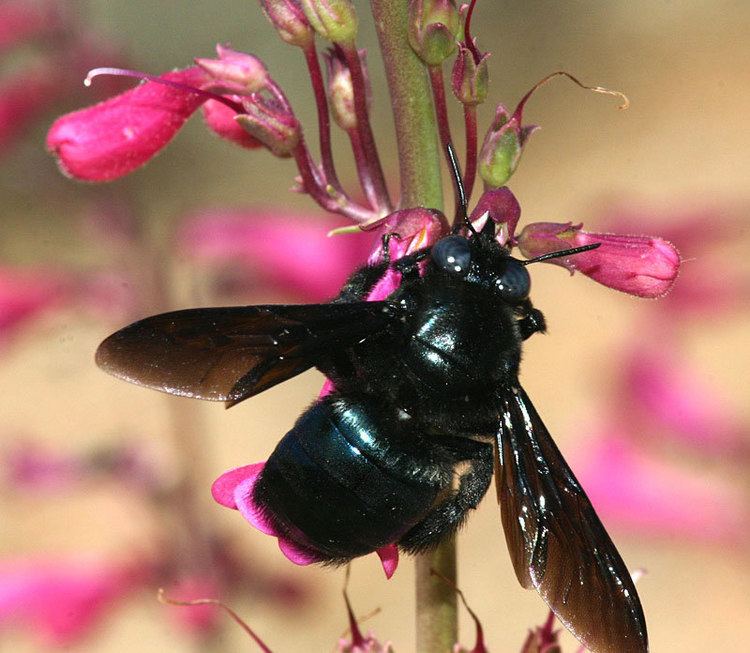
The French entomologist Pierre André Latreille described the genus in 1802. He derived the name from the Ancient Greek xylokopos/ξυλοκὀπος "wood-cutter".
Characteristics
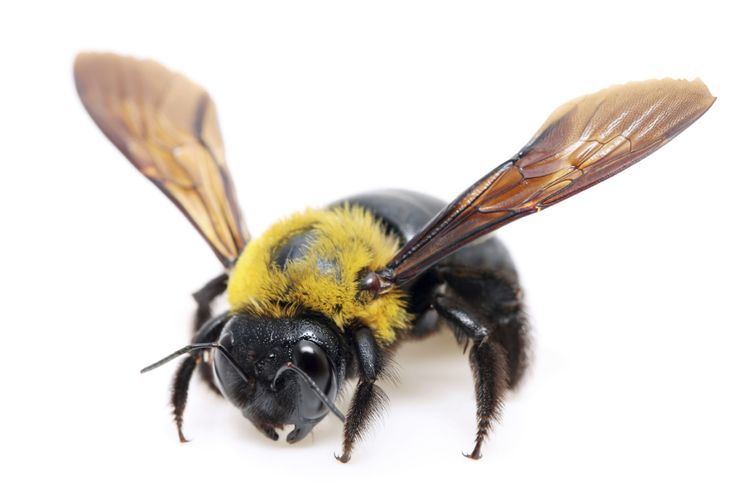
Many species in this enormous genus are difficult to tell apart; most species are all-black, or primarily black with some yellow or white pubescence. Some differ only in subtle morphological features, such as details of the male genitalia. Males of some species differ confusingly from the females, being covered in greenish-yellow fur. The confusion of species arises particularly in the common names; in India, for example, the common name for any all-black species of Xylocopa is bhanvra, and reports and sightings of bhanvra are commonly misattributed to a European species, Xylocopa violacea; however, this species is found only in the northern regions of Jammu and Kashmir and Punjab, and most reports of bhanvra, especially elsewhere in India, refer to any of roughly 15 other common black Xylocopa species in the region, such as X. nasalis, X. tenuiscapa, or X. tranquebarorum.
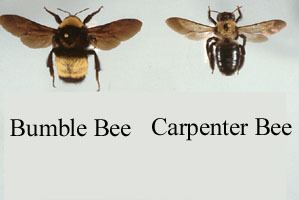
Non-professionals commonly confuse carpenter bees with bumblebees.; the simplest rule of thumb for telling them apart is that most carpenter bees have a shiny abdomen, whereas bumblebee abdomens are completely covered with dense hair. Males of some species of carpenter bees have a white or yellow face, unlike bumblebees, while females lack the bare corbicula of bumblebees; the hind leg is entirely hairy.
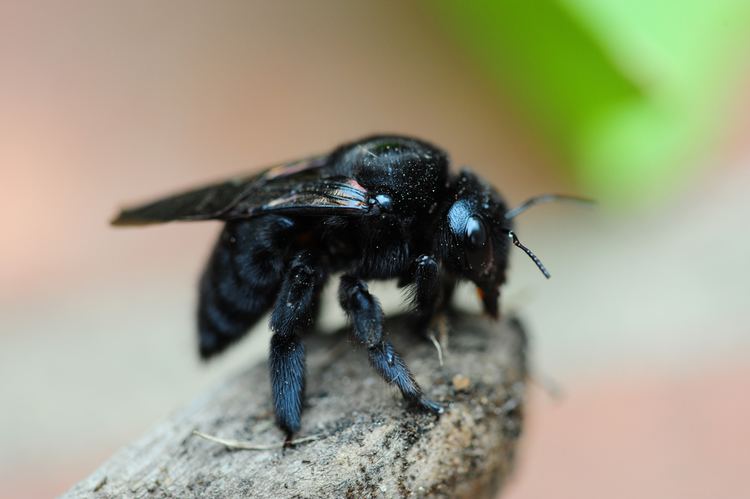
The wing venation is characteristic; the marginal cell in the front wing is narrow and elongated, and its apex bends away from the costa. The front wing has small stigma. When closed, the bee's short mandibles conceal the labrum. The clypeus is flat. Males of many species have much larger eyes than the females, which relates to their mating behavior.
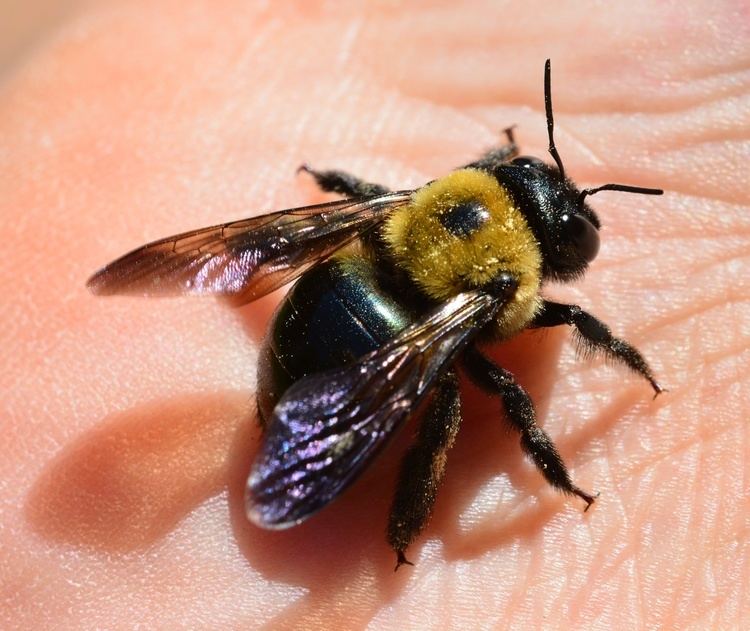
In the United States, two eastern species, Xylocopa virginica and X. micans, occur. Three more species are primarily western in distribution, X. varipuncta, X. tabaniformis orpifex, and X. californica. X. virginica is by far the more widely distributed species.
Ecological significance
In several species, the females live alongside their own daughters or sisters, creating a small social group. They use wood bits to form partitions between the cells in the nest. A few species bore holes in wood dwellings. Since the tunnels are near the surface, structural damage is generally minor or superficial.
Carpenter bees have short mouthparts and are important pollinators on some open-faced or shallow flowers; for some they even are obligate pollinators, for example the maypop (Passiflora incarnata) and Orphium, which are not pollinated by any other insects. They also are important pollinators of flowers with various forms of lids, such as Salvia species and some members of the Fabaceae. However many carpenter bees "rob" nectar by slitting the sides of flowers with deep corollae. Xylocopa virginica is one example of a species with such nectar robbing behavior. With their short labia the bees cannot reach the nectar without piercing the long-tubed flowers; they miss contact with the anthers and perform no pollination. In some plants, this reduces fruit and seed production, while others have developed defence mechanisms against nectar robbing. When foraging for pollen from some species with tubular flowers however, the same species of carpenter bees still achieve pollination, if the anthers and stigmata are exposed together.
Many Old World carpenter bees have a special pouch-like structure on the inside of their first metasomal tergite called the acarinarium where certain mites (Dinogamasus species) reside as commensals. The exact nature of the relationship is not fully understood, though in other bees that carry mites, they are beneficial, feeding either on fungi in the nest, or on other harmful mites.
Behavior
Carpenter bees are traditionally considered solitary bees, though some species have simple social nests in which mothers and daughters may cohabit. Examples of this type of social nesting can be seen in the species Xylocopa sulcatipes and Xylocopa nasalis. When females cohabit, a division of labor between them occurs sometimes. In this type of nesting, multiple females either share in the foraging and nest laying, or one female does all the foraging and nest laying, while the other females guard.
Solitary species differ from social species. Solitary bees tend to be gregarious and often several nests of solitary bees are near each other. In solitary nesting, the founding bee forages, builds cells, lays the eggs, and guards. Normally, only one generation of bees live in the nest. Xylocopa pubescens is one carpenter bee species that can have both social and solitary nests.
Carpenter bees make nests by tunneling into wood, bamboo, and similar hard plant material such as peduncles, usually dead. They vibrate their bodies as they rasp their mandibles against hard wood, each nest having a single entrance which may have many adjacent tunnels. As a subfamily, they attack a wide range of host plants, but any one species may show definite adaptations or preferences for particular groups of plants. The entrance is often a perfectly circular hole measuring about 16 mm (0.63 in) on the underside of a beam, bench, or tree limb. Carpenter bees do not eat wood. They discard the bits of wood, or reuse particles to build partitions between cells. The tunnel functions as a nursery for brood and storage for the pollen/nectar upon which the brood subsists. The provision masses of some species are among the most complex in shape of any group of bees; whereas most bees fill their brood cells with a soupy mass and others form simple spheroidal pollen masses, Xylocopa species form elongated and carefully sculpted masses that have several projections which keep the bulk of the mass from coming into contact with the cell walls, sometimes resembling an irregular caltrop. The eggs are very large relative to the size of the female, and are some of the largest eggs among all insects.
Two very different mating systems appear to be common in carpenter bees, and often this can be determined simply by examining specimens of the males of any given species. Species in which the males have large eyes are characterized by a mating system where the males either search for females by patrolling, or by hovering and waiting for passing females, which they then pursue. In the other mating system, the males often have very small heads, but a large, hypertrophied glandular reservoir is in the mesosoma, which releases pheromones into the airstream behind the male while it flies or hovers. The pheromone advertises the presence of the male to females.
Male bees often are seen hovering near nests, and will approach nearby animals. However, males are harmless, since they do not have a stinger. Female carpenter bees are capable of stinging, but they are docile and rarely sting unless caught in the hand or otherwise directly provoked.
Natural predators
Woodpeckers eat carpenter bees, as do various species of birds, such as shrikes and bee-eaters as well as some mammals such as ratels. Other predators include large species of Mantodea and predatory flies, particularly large species of the family Asilidae. Woodpeckers are attracted to the noise of the bee larvae and drill holes along the tunnels to feed on them.
Apart from outright predators, parasitoidal species of bee flies (e.g. Xenox) lay eggs in the entrance to the bee’s nest and the fly maggots live off the bee larvae.
